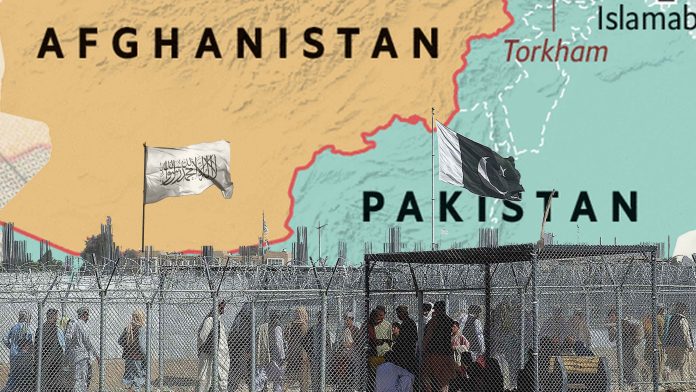
By Brig Syed Karrar Hussain Retired
Security dynamics along the Pakistan–Afghanistan border have become increasingly fraught. Frequent cross-border attacks, allegations of militant sanctuaries, porous terrain, and political mistrust have combined to fuel clashes between Pakistan and the Afghan Taliban government. In addition to internal challenges, regional powers—including India—are viewed by many in Pakistan and Afghanistan as playing proxy roles, adding another layer of complexity. This article examines the background, the roles of different actors (including India), current allegations, and guidelines so that the Afghan caretaker government and public can avoid being manipulated, while reducing tension and stopping terrorist attacks.
Background: Refugees, Borders, Militancy
1. Long-term Afghan Refugee Presence in Pakistan
Since the Soviet invasion in the late 1970s, Pakistan has hosted millions of Afghan refugees. Over decades, these populations have become deeply interwoven socially and economically with Pakistani border provinces. Pakistani society has borne humanitarian and financial burdens, while also accommodating cross-cultural and tribal connections.
2. Porous Border & Border Dispute
The Durand Line, the roughly 2,600-km border between Afghanistan and Pakistan, passes through remote mountainous regions. Many of these areas have weak state presence. Tribal and kinship ties cross the line, complicating the enforcement of border controls. Some in Afghanistan (including factions of the Taliban) do not formally accept the Durand Line as the definitive interstate boundary.
3. Militant Safe Havens and Cross-Border Attacks
Pakistan claims that terrorist groups like the Tehreek-e-Taliban Pakistan (TTP), IS-KP, and others use Afghan territory as hideouts for planning and executing attacks on Pakistani civilians and security forces. Pakistani military responses and strikes, including cross-border operations and airstrikes, follow. Afghanistan often counters that such actions violate sovereignty, produce civilian harm, and that it lacks sufficient capacity or resources to control all non-state actors.
The Role of India in the Afghanistan–Pakistan Dynamic
In recent years, India has been increasing its diplomatic, economic, and humanitarian engagement with Afghanistan. Some of these moves are driven by strategic considerations—balancing Pakistan, countering influence from other regional actors, ensuring regional economic connectivity, and securing trade routes. Below are some relevant developments and perceptions:
1. Reopening of Embassy, Deepening Diplomatic Ties
India has announced reopening its embassy in Kabul and upgrading its mission from a technical team to full embassy status. This reflects a deeper diplomatic engagement with the Taliban government, even as recognition of that government remains limited.
2. Statements on Terrorism & Shared Threats
In diplomatic meetings, India has emphasized that terrorism emanating from “regional countries” is a common threat, calling for cooperation against groups like Lashkar-e-Tayyiba (LeT) and Jaish-e-Mohammed (JeM), and insisting that Afghan soil not be used against Indian interests.
3. Investment, Aid and Infrastructure Projects
India has long provided development aid in Afghanistan—building roads, dams, schools, hospitals, etc. Afghanistan sees India as a potential partner for trade, infrastructure, and economic development (e.g. via Chabahar Port) to bypass Pakistani routes.
4. Perceptions and Allegations
From the Pakistani side, there are claims that India’s intelligence agency RAW has been involved in subversive activities against Pakistan—from allegedly supporting militant groups or giving ideological/informational support, to aiding groups that carry out attacks. For example, Pakistani military officials have alleged that RAW, together with Afghan intelligence (in past regimes), helped militants including TTP and IS to operate.
On the Afghan Taliban side, statements have indicated that while India is welcome to invest and run diplomatic missions, any overt intelligence or military presence is unwelcome. For instance, in 2022, the Taliban told an Indian delegation that “there is no room for such [RAW/intelligence] activities in Afghanistan.”
These developments are significant, because they raise questions: To what extent is India acting purely in diplomatic, economic, or humanitarian roles, and to what extent might there be more covert strategic (proxy) aims? From Pakistan’s perspective, the concern is that Indian influence in Afghanistan might coincide with or enable anti-Pakistan militancy. From Afghanistan’s side, the risk is of becoming a stage where multiple neighbours use Afghan territory to forward their own interests, which can provoke retaliation and insecurity.
Present Claims & Tensions
Pakistan’s perspective:
Pakistan insists that militants—especially TTP—use safe havens in Afghanistan and carry out attacks on Pakistani soldiers and civilians. It further alleges that India (through RAW) and possibly Afghan intelligence agencies have supported or facilitated militant operations to destabilize Pakistan. Islamabad argues that stronger Afghan action is needed to dismantle sanctuaries and stop cross-border infiltration.
Afghanistan/Taliban perspective:
The caretaker government often claims to uphold Afghan sovereignty and rejects the idea that it is complicit with foreign intelligence operations. Taliban leaders have indicated that Afghanistan will not permit use of its soil against other countries. At the same time, they often claim limited capacity or internal constraints, especially in remote provinces. They also point to violations by Pakistan (airstrikes, shelling) as breaches of their territory.
Concerns of the Afghan Public:
Ordinary Afghan citizens suffer from insecurity, economic hardship, displacement, humanitarian crises. Heavy-handed counterterrorism by neighboring states, if involving Afghan territory, can exacerbate civilian casualties, spark local resentment, and reduce the legitimacy of the caretaker government. If the public feels that their government is being used as a pawn in regional games—particularly between India and Pakistan—it undermines social cohesion and stability.
Islamic Ethical and Neighbourhood Norms
Sanctity of Life & Protection of Innocents: Islamic jurisprudence emphasizes that harming innocent people is prohibited. Terrorist attacks against civilians or misuse of territory that leads to civilian harm violate these principles.
Justice and Prevention of Oppression: If militants operate from one country and carry out attacks in another, there is a duty under Islamic ethics to prevent injustice, whether by removing safe havens or by taking measures to avoid wrongful aggression.
Good Neighbourship (Ḥusn al-Jāwar): Neighbouring states bear rights and responsibilities to treat each other fairly, avoid actions that harm the other, and engage in good faith diplomacy.
Avoiding False Accusations / Fabrications, Upholding Trust: Islam prohibits spreading falsehoods. If accusations are made (e.g. of intelligence work), they should be supported by credible evidence. Distrust born of unverified claims damages regional stability.
Guidelines & Recommendations
To reduce tensions, prevent terrorist attacks, and avoid becoming proxies in regional rivalries, the following guidelines are proposed—for the Afghan caretaker government, for the Afghan public, and for Pakistan and India.
Stakeholder Recommendation Purpose / Outcome
Afghan Caretaker Government 1. Uphold strict border non-use policy: Publicly declare and enforce that Afghanistan will not allow its territory to be used for terrorist acts against any neighbour. Monitor and prevent groups from establishing sanctuaries. Ensure that foreign intelligence agencies (if any) do not have operational outposts on Afghan soil. This builds credibility, reduces accusations of being a proxy; deters neighbours from retaliatory strikes; increases internal trust.
2. Enforce oversight and transparency in foreign engagement: Any major aid, development, or diplomatic cooperation (including with India or Pakistan) should have clear terms, oversight by Afghan authorities, judicial or legislative review. Avoid secret agreements that could be used by foreign powers to exert undue influence. Prevents covert proxying; strengthens government legitimacy; gives Afghan public visibility into what foreign actors are doing.
3. Promote national unity and public awareness: Engage civil society, religious leaders, tribal elders to educate on risks of foreign meddling; promote narratives of Afghan sovereignty; emphasize the harms of militant activity and of being drawn into regional conflicts. A well-informed public is less likely to be manipulated; local legitimacy increases capacity to resist external pressure.
Afghan Public 4. Demand accountability: Seek evidence and transparency from the government: what foreign actors are present, what their roles are. Support institutions (media, judiciary) to investigate claims of foreign intelligence operations or sabotage. Helps reduce rumours and misperceptions; keeps government honest; discourages foreign actors from operating secretly.
5. Resist radicalization and support peaceful dialogue: Communities along the border should be encouraged to reject militant recruitment; local leadership should mediate grievances; avoid allowing local issues to be co-opted by foreign agendas. Reduces the pool of recruits; stabilises border regions; cuts off local support that proxies might use.
Pakistan 6. Share credible actionable intelligence: Pakistan should present clear evidence of external involvement when making allegations. Cooperate with Afghanistan in verifying claims rather than unilaterally public accusations without dialogue. This prevents mis-escalation; builds trust; helps avoid the perception that Pakistan is blaming others to deflect internal issues.
7. Avoid collective punishments and civilian harm: Any counterterrorism or border operations should take care to minimise harm to civilians. Respect Afghan sovereignty where possible. Use diplomacy first, and when using force, ensure proportionality and prior warning where feasible. Reduces local backlash; strengthens moral position; aligns with Islamic norms.
India 8. Clarify and limit roles of intelligence agencies: India should avoid any appearance or reality of supporting militant operations against Pakistan; ensure intelligence cooperation is in line with legal, diplomatic norms. If RAW or other agencies have been involved in controversial actions, India should allow independent investigation or at least transparency. Limits the risk of being labeled a proxy; reduces escalation; enhances regional credibility.
9. Balance diplomatic engagement with non-interference: India’s diplomatic missions, investments, humanitarian projects in Afghanistan are legitimate. However, India should ensure that these activities are not conflated with covert operations; avoid rhetoric that could inflame regional tensions. Helps sustain goodwill; mitigates risk Afghanistan is seen as staging ground for operations; preserves peace.
Bilateral & Regional Measures 10. Tripartite or multilateral oversight mechanism: Establish a framework involving Pakistan, Afghanistan, and India (and maybe neutral third parties or Islamic organisations) to review claims of cross-border terrorism, foreign intelligence interference, and violations. Could include periodic joint investigations. Increases transparency; reduces unilateral blame games; institutionalises conflict resolution.
11. Legal/international mechanisms: Use legal frameworks (bilateral treaties, international law, UN standards) to define obligations: extradition, non-harboring of terrorists, respecting sovereignty, and avoiding proxy wars. Grounds behaviour in law; gives recourse in international fora; raises cost of violations.
12. Confidence-building measures: Small steps, such as mutual recognition of some border posts, joint patrols in sensitive zones, humanitarian cooperation (disaster relief, refugees), and public diplomacy to reduce hate speech between countries. Builds trust; creates shared interest; reduces the likelihood of misunderstanding or escalation.
Possible Obstacles & How to Mitigate Them
Severely distrust among states: Pakistan, Afghanistan, India all carry historical grievances. Mitigation: start with low-risk cooperation (medical aid, refugee welfare), and transparent, public reporting.
Opacity of intelligence work: Covert operations are hard to verify. Mitigation: adopt independent oversight, involve courts, media, or third-party monitors.
Domestic political pressure: In each country, there are voices demanding tough responses, or accusing governments of weakness. Leaders must balance security with diplomacy; must communicate costs of escalation to publics.
Ideological drivers: Some militant groups thrive on external support or ideological alignment. Countering radicalization at local level (schools, mosques), ensuring economic opportunity, social inclusion are long-term tasks.
Economic constraints: Afghanistan government’s limited resources; Pakistan’s border control costs; India’s aid funding priorities. Mitigation: seek regional/international assistance, avoid overcommitment.
Roadmap: Short, Medium, Long Term with Proxy Risk in Mind
Time Frame Key Actions
Short-Term (immediate to 6 months) • Afghan caretaker government issues clear public statements rejecting use of Afghan soil for attacks against any neighbour; excludes foreign intelligence stations without oversight. <br> • Pakistan and India agree on a joint investigative protocol for any cross-border incidents. Border crossings remain open for trade/humanitar purposes; avoid blockades. Increase grassroots dialogue in affected border communities; religious and tribal leaders speak out against being pawns in proxy conflicts.
Medium Term (6-18 months) • Set up a tri-party oversight body (Afghanistan-Pakistan-India), possibly with neutral observatories, to monitor cross-border terrorism; handle evidence sharing. Institutionalize Afghan legal review of foreign projects: any diplomatic, development, or investment work must be subject to legal/institutional transparency to avoid cover for intelligence work. Joint border management: controlled patrols, gate-oriented crossings, fencing or monitoring where appropriate but with community consultation. <br> • Civil society media campaigns to inform public about regional proxy risks. <br> • Training, capacity building for Afghanistan’s border forces to detect militant movement while respecting human rights.
Long Term (2-5 years and beyond) • Forge legal treaties among Pakistan, Afghanistan, India that enshrine non-use of territory for aggression or for proxy operations; establish binding mechanisms for violation. <br> • Economic interdependence: enhance trade corridors, infrastructure projects that benefit local populations so border areas derive benefit and have stake in peace. Political inclusion in Afghanistan: ensure all ethnic and tribal groups feel represented so that internal legitimacy reduces susceptibility to foreign influence. <br> • Regional forums or Islamic cooperation organisations to monitor compliance; aspiring to collective security pacts in South Asia that reduce incentive for covert conflict. <br> • Encourage external donor and multilateral support for Afghanistan that is transparent, conditionally linked to sovereignty and good governance, not to providing leverage to foreign intelligence operations.
Conclusion
The Pakistan–Afghanistan border clashes are not merely bilateral security issues—they are intertwined with regional geopolitics, historical mistrust, refugee crises, and the risk of being drawn into proxy conflicts. India’s growing engagement with the Taliban regime—diplomatically, economically, and rhetorically—is viewed by many in Pakistan as having potential proxy implications. At the same time, there is risk for Afghanistan to become a field where external intelligence agencies or states push their agendas, thereby exacerbating instability, conflict, and undermining Afghan sovereignty.
To avoid this, the Afghan caretaker government and people should insist on transparency, reject being a tool in intelligence or proxy conflicts, maintain firm territorial non-use policies, seek broad public legitimacy, and anchor foreign involvement in law, ethics, and mutual respect. Pakistan and India must also play roles of restraint: avoid undue accusations without evidence, limit covert operations that inflame distrust, and engage in diplomacy and shared mechanisms to resolve disputes.
Drawing on Islamic principles—justice, protection of innocent lives, neighbourly good relations—and international norms, there is a pathway toward reducing violence, stopping cross-border terrorism, and fostering stability. It will require courage, honesty, and cooperation from all parties: the Afghan caretaker government, Pakistan, India, and regional/international actors. But such efforts are essential; without them, border tensions will continue to exact heavy costs in lives, human suffering, and regional peace.

























